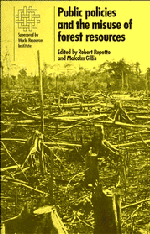Book contents
- Frontmatter
- Contents
- Contributors
- Foreword
- Acknowledgments
- 1 Overview
- 2 Indonesia: public policies, resource management, and the tropical forest
- 3 Malaysia: public policies and the tropical forest
- 4 Incentive policies and forest use in the Philippines
- 5 Price and policy: the keys to revamping China's forestry resources
- 6 Public policy and deforestation in the Brazilian Amazon
- 7 West Africa: resource management policies and the tropical forest
- 8 Subsidized timber sales from national forest lands in the United States
- 9 Conclusion: findings and policy implications
- Index of Topics
4 - Incentive policies and forest use in the Philippines
Published online by Cambridge University Press: 06 July 2010
- Frontmatter
- Contents
- Contributors
- Foreword
- Acknowledgments
- 1 Overview
- 2 Indonesia: public policies, resource management, and the tropical forest
- 3 Malaysia: public policies and the tropical forest
- 4 Incentive policies and forest use in the Philippines
- 5 Price and policy: the keys to revamping China's forestry resources
- 6 Public policy and deforestation in the Brazilian Amazon
- 7 West Africa: resource management policies and the tropical forest
- 8 Subsidized timber sales from national forest lands in the United States
- 9 Conclusion: findings and policy implications
- Index of Topics
Summary
History of forest use
History of deforestation
At the start of the century, the Philippine archipelago was covered with rich dipterocarp forests. Today, forests have disappeared in many places, and those that remain are concentrated on a few islands: Mindanao, Palawan, Samar, and pockets of eastern Luzon. In 1982, the government reported that 16.6 million hectares, or 55 percent of the country's land area, were forest lands, of which 11.2 million hectares were forested. About 9 percent of the country, or 2.7 million hectares, was said to be virgin forests. Yet the rate at which virgin forests declined is astounding. From 1971 to 1980, they decreased by 1.7 million hectares, with 1.1 million converted permanently to nonforest uses (Reyes 1983). Table 4.1 summarizes the status of the forest area of the Philippines.
However, these government statistics have been disputed in recent years. One study (Revilla 1984), using Landsat photos, estimated forested lands at only 8.9 million hectares, 0.6 million hectares of them in alienable and disposable lands. In another study (Revilla 1984) Landsat photos for 1976 suggested that only about 8.5 to 9 million hectares of forest lands were forested in 1976, and that the total had been reduced to 7.8 to 8.3 million hectares by 1983. This study estimated there were 2 to 2.5 million fewer hectares of virgin forest than the government's figure of 2.7 million hectares. These discrepancies may be corrected with the completion of the second national forest inventory, begun in 1981. Meanwhile, the lower figures seem more credible.
Deforestation in the Philippines began to accelerate in the post-independence era following the Second World War.
- Type
- Chapter
- Information
- Public Policies and the Misuse of Forest Resources , pp. 165 - 204Publisher: Cambridge University PressPrint publication year: 1988
- 9
- Cited by

